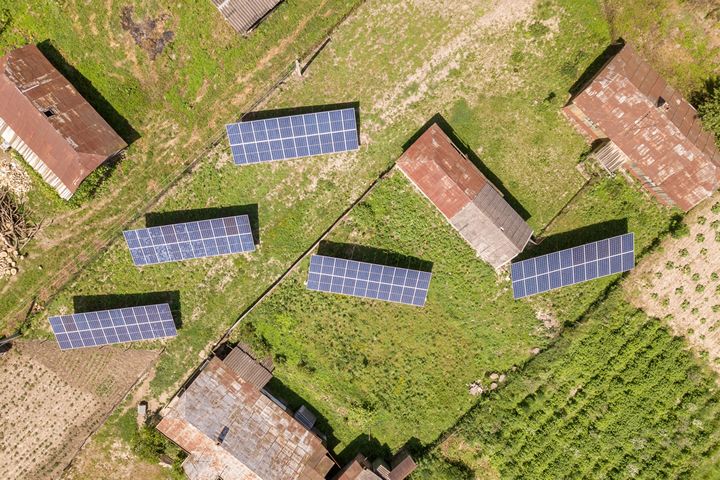The 2022 National Young Farmer Survey, a survey conducted by the National Young Farmers Coalition, found that land access is the number one challenge faced by young farmers.
 How Agrivoltaics Can Help Solve Land Access Challenges for Emerging and Young Farmers
How Agrivoltaics Can Help Solve Land Access Challenges for Emerging and Young Farmers

Peter Schmitt, Director of Development | US Solar
Land access is one of the most significant barriers faced by young and emerging farmers throughout Minnesota. With limited availability of affordable, high-quality farmland, especially on long-term contracts, many aspiring farmers struggle to break into the industry. A promising solution lies in maximizing land productivity by combining solar energy production with agriculture – a practice known as “agrivoltaics”.
Who are Emerging Farmers?
Emerging farmers, as defined by the Minnesota Department of Agriculture, include communities who have been historically underserved, such as young, BIPOC, disabled, veteran, immigrant, LGBTQ+, and female farmers. The term “emerging farmers” is used to reflect the diversity of farmers, and it brings attention to the barriers that impact a variety of farming communities, such as land accessibility.
The 2022 National Young Farmer Survey, a survey conducted by the National Young Farmers Coalition, found that land access is the number one challenge faced by young farmers. Out of 10,000 young and BIPOC farmers surveyed nationwide, 59% identified access to affordable farmland as very or extremely challenging, while 39% stated that maintaining access to land was a key challenge.
What is Agrivoltaics?
Agrivoltaics is an innovative and rapidly growing concept that integrates solar energy production with agriculture, creating a dual-purpose use of land. By combining farming activities like crop production, livestock grazing, and pollinator habitats with ground-mounted solar installations, agrivoltaics maximizes land efficiency and productivity.
According to the National Renewable Energy Laboratory (NREL), agrivoltaics offers numerous benefits:
- Increased crop yields and livestock productivity. The partial shade from solar installations creates optimal conditions for certain types of crops to thrive, as well as respite from the sun for grazing livestock and farmers.
- Enhanced stormwater management and ecosystem services
- Creation of pollinator habitats
- Reduced solar site maintenance costs
- Stable land access opportunity for farmers
Among its many advantages, agrivoltaics addresses a critical barrier for emerging farmers: stable and affordable land access. By fostering partnerships between solar developers and agricultural organizations, agrivoltaics projects can offer emerging farmers long-term access to farmland, reducing financial pressures and allowing them to focus on building their businesses.
Supporting Emerging Farmers Through Agrivoltaics
Through NREL’s InSPIRE Program, the U.S. Department of Energy is supporting agrivoltaics through 22 project sites across the nation. These sites bring together researchers, industry experts, and farmers to demonstrate the potential of agrivoltaics to transform land use.
A Minnesota Success Story
One standout example is a project located in Big Lake, Minnesota, where a local solar developer has partnered with Big River Farms (BRF), a program of The Food Group and an organization that champions emerging farmers. The land at the Big Lake site has been made openly available to BRF and its farmer participants at no cost. Hand-harvested crops, agricultural research, and honey production are just a few of the activities that occur at the solar farm.
Farmers use the site to plant their crops in rows between solar panels, maximizing land productivity. As part of this agrivoltaics partnership, emerging farmers receive BRF program resources to support successful crop production and gain access to the land for free. This arrangement enables farmers to build their markets without the financial stress and uncertainty of short-term land leases. The benefits ripple outward: farmers can provide for their families, invest in the soil, strengthen their businesses, and contribute to local economic growth.
A Path Forward
Agrivoltaics offers a compelling solution to a primary barrier faced by both young and emerging farmers – land access. As the number of large-scale solar projects continues to grow, it is important to consider the array of co-benefits that come with integrating agricultural activities. By implementing agrivoltaics and forming agrivoltaics partnerships, emerging farmers can gain access to the land that they need to successfully produce crops. With agrivoltaics, land access, enhanced land productivity, clean energy, and economic growth are all possible – all of which positively impact the environment, farmers and local communities.
 Peter Schmitt is a Director of Development for US Solar, responsible for developing solar projects around the country. He focuses on a practice called agrivoltaics (agriculture + photovoltaics), which combines solar design with farming by including pollinator habitat, beehives, honey production, grazing sheep, and even organic crop production under and around the solar arrays. Peter is an avid Minnesota sports fan and never misses a chance to celebrate his German heritage.
Peter Schmitt is a Director of Development for US Solar, responsible for developing solar projects around the country. He focuses on a practice called agrivoltaics (agriculture + photovoltaics), which combines solar design with farming by including pollinator habitat, beehives, honey production, grazing sheep, and even organic crop production under and around the solar arrays. Peter is an avid Minnesota sports fan and never misses a chance to celebrate his German heritage.
The content & opinions in this article are the author’s and do not necessarily represent the views of AgriTechTomorrow
Comments (0)
This post does not have any comments. Be the first to leave a comment below.
Featured Product

